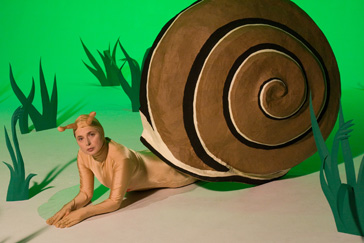by Thersa Wiltz
This is compelling television to be sure–after all, we’re talking about sex: hippies cavorting in the altogether. Women’s libbers brandishing their bras. Playboy bunnies and Hugh Hefner. Helen Gurley Brown and Burt Reynolds’s naked centerfold. Suburban swingers. Jaybird-naked couples shedding what remains of their inhibitions at the infamous Plato’s Retreat. Drag queens and porn stars.
But there’s something missing from this made-in-America tableau: Almost every single one of the characters in the spotlight is white.
Such is the case with VH1′s new, four-part documentary series: “Sex: The Revolution,” which debuts tomorrow night. “Sex” presents a sweeping survey of the seismic changes in 20th-century American sexual mores, and the legal and cultural shifts that resulted from it. A large part of the problem is that it tries to do too much, tossing out historical highlights and lowlights at breathtaking speed.
The talking heads who shape the discourse over four hours–Erica Jong, Armistead Maupin, Hefner and Gloria Steinem — tend to be the usual suspects, while black and brown folks get shoved to the background. They’re the soundtrack through which white folks found sexual salvation. (Cue the Little Richard music. See the stoned sister falling out of her dress at Studio 54.)
“It’s true,” says Hart Perry, who directed the series along with Richard Lowe. “At one point, we were dealing with the cultural crossover between black and white . . . when we talk about rock-and-roll. I wanted to talk about Norman Mailer, the ‘White Negro.’ . . . [But] there was too much competition for stories. This is certainly not the definitive story on the sexual revolution.”
It is a story of the sexual revolution, shown through “the artifacts of culture,” news footage, films, music videos, photographs, with a chorus of white boomers commenting on the action, and reminiscing about times gone by. Melvin Van Peebles, black feminist Michele Wallace, Danny Glover and musician Nile Rodgers make brief appearances; no Latinos or Asians are interviewed. (Glover on San Francisco’s “Summer of Love”: “It was about taking mescaline and getting laid. Or smoking weed and getting laid.”)
Question: How can you talk about the cultural icons of the sexual revolution and not discuss blaxploitation diva Pam Grier? Or extol the significance of a loincloth-clad Jo Raquel Tejada, a.k.a. Raquel Welch, in “One Million Years B.C.”? Why is it that instead we are told that the poster girl for the female orgasm was Jane Fonda in “Barbarella”? Or Marilyn Chambers, the Ivory Snow soap model gone bad in “Behind the Green Door”?
(more . . . )







